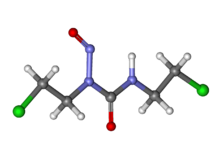Chemistry:Carmustine

| |

| |
| Names | |
|---|---|
| IUPAC name
1,3-Bis(2-chloroethyl)-1-nitrosourea[1]
| |
| Other names
N,N'-Bis(2-chloroethyl)-N-nitrosourea, bis-chloroethylnitrosourea, BCNU
| |
| Identifiers | |
3D model (JSmol)
|
|
| ChEBI | |
| ChEMBL | |
| ChemSpider | |
| DrugBank | |
| EC Number |
|
| KEGG | |
| MeSH | Carmustine |
PubChem CID
|
|
| RTECS number |
|
| UNII | |
| UN number | 2811 |
| |
| |
| Properties | |
| C5H9Cl2N3O2 | |
| Molar mass | 214.05 g·mol−1 |
| Appearance | Orange crystals |
| Odor | Odourless |
| Melting point | 30 °C (86 °F; 303 K) |
| log P | 1.375 |
| Acidity (pKa) | 10.194 |
| Basicity (pKb) | 3.803 |
| Pharmacology | |
| 1=ATC code }} | L01AD01 (WHO) |
| |
| License data | |
| Legal status | |
| Hazards | |
| GHS pictograms |  
|
| GHS Signal word | DANGER |
| H300, H350, H360 | |
| P301+310, P308+313 | |
| Lethal dose or concentration (LD, LC): | |
LD50 (median dose)
|
20 mg kg−1 (oral, rat) |
| Related compounds | |
Related ureas
|
Dimethylurea |
Related compounds
|
|
Except where otherwise noted, data are given for materials in their standard state (at 25 °C [77 °F], 100 kPa). | |
| Infobox references | |
| Clinical data | |
|---|---|
| Trade names | BiCNU, Gliadel |
| AHFS/Drugs.com | Monograph |
| MedlinePlus | a682060 |
| License data |
|
| Drug class | Antineoplastic agents |
Carmustine, sold under the brand name BiCNU among others, is a medication used mainly for chemotherapy. It is a nitrogen mustard β-chloro-nitrosourea compound used as an alkylating agent.[6]
Description
Carmustine is an orange-yellow solid medication used mainly for chemotherapy. It is a nitrogen mustard β-chloro-nitrosourea compound.[7]
Mechanism of action
As an alkylating agent, carmustine can form interstrand crosslinks in DNA, which prevents DNA replication and DNA transcription.[8]
Uses
Carmustine is used as an alkylating agent to treat several types of brain cancer including glioma, glioblastoma multiforme, medulloblastoma and astrocytoma, multiple myeloma, and lymphoma (Hodgkin's and non-Hodgkin).
Carmustine is sometimes used in conjunction with alkyl guanine transferase (AGT) inhibitors, such as O6-benzylguanine. The AGT-inhibitors increase the efficacy of carmustine by inhibiting the direct reversal pathway of DNA repair, which will prevent formation of the interstrand crosslink between the N1 of guanine and the N3 of cytosine.
It is also used as part of a chemotherapeutic protocol in preparation for hematological stem cell transplantation, a type of bone marrow transplant, in order to reduce the white blood cell count in the recipient.[9] Use under this protocol, usually with fludarabine and melphalan, was developed by oncologists at the University of Texas MD Anderson Cancer Center.[citation needed]
Implants
In the treatment of brain tumours, the U.S. Food and Drug Administration (FDA) approved biodegradable discs infused with carmustine (Gliadel).[10] They are implanted under the skull during a surgery called a craniotomy. The disc allows for controlled release of carmustine in the extracellular fluid of the brain, thus eliminating the need for the encapsulated drug to cross the blood-brain barrier.[11]
Production
Carmustine for injection was marketed under the name BiCNU by Bristol-Myers Squibb[12] and now[when?] by Emcure Pharmaceuticals.[13] In India it is sold under various brand names, including Consium.[citation needed]. The product is available as a generic version with other manufacturers offering the product licensed in the US and EU markets.[citation needed]
See also
References
- ↑ CID 2578 from PubChem
- ↑ "Carmustine 100mg Powder and solvent for Solution for Infusion - Summary of Product Characteristics (SmPC)". 24 March 2020. https://www.medicines.org.uk/emc/product/11176/smpc.
- ↑ "Gliadel 7.7mg Implant - Summary of Product Characteristics (SmPC)". 15 June 2020. https://www.medicines.org.uk/emc/product/36/smpc.
- ↑ "Bicnu- carmustine kit". https://dailymed.nlm.nih.gov/dailymed/drugInfo.cfm?setid=d6cbb63c-e0b1-43ee-ad6f-408da0772079.
- ↑ "Gliadel- carmustine wafer". https://dailymed.nlm.nih.gov/dailymed/drugInfo.cfm?setid=38962a55-a514-4c48-bea5-f99a8da4beec.
- ↑ "Chapter 6 - DNA-Interactive Agents" (in en). The Organic Chemistry of Drug Design and Drug Action (Third ed.). Boston: Academic Press. January 2014. pp. 275–331. doi:10.1016/b978-0-12-382030-3.00006-4. ISBN 978-0-12-382030-3.
- ↑ Rider, Barbara J. (2007-01-01), Enna, S. J.; Bylund, David B., eds., "Carmustine" (in en), xPharm: The Comprehensive Pharmacology Reference (New York: Elsevier): pp. 1–4, doi:10.1016/b978-008055232-3.61389-3, ISBN 978-0-08-055232-3, https://www.sciencedirect.com/science/article/pii/B9780080552323613893, retrieved 2022-03-29
- ↑ "NLM PubChem CID Index", Vitamin D Handbook (Hoboken, NJ, USA: John Wiley & Sons, Inc.): pp. 239–244, 2007, doi:10.1002/9780470238165.indsp1, ISBN 9780470238165
- ↑ "Carmustine replacement in intensive chemotherapy preceding reinjection of autologous HSCs in Hodgkin and non-Hodgkin lymphoma: a review". Bone Marrow Transplantation 52 (7): 941–949. July 2017. doi:10.1038/bmt.2016.340. PMID 28112752.
- ↑ "Treatment of single brain metastasis with resection, intracavity carmustine polymer wafers, and radiation therapy is safe and provides excellent local control". Clinical Cancer Research 13 (12): 3637–3641. June 2007. doi:10.1158/1078-0432.CCR-06-2095. PMID 17575228.
- ↑ "Hopkins Medicine Magazine - In Spite of All Odds". http://www.hopkinsmedicine.org/hmn/W05/feature3.cfm.
- ↑ "Company Statement on BiCNU® (carmustine for injection)". Bristol-Myers Squibb Company. https://www.bms.com/life-and-science.html.
- ↑ "Emcure Press release". http://www.emcure.co.in/news/docs/BiCNU%20Emcure%20press%20release.pdf.
External links
- "Carmustine". Drug Information Portal. U.S. National Library of Medicine. https://druginfo.nlm.nih.gov/drugportal/name/carmustine.
- "Carmustine Implant". https://medlineplus.gov/druginfo/meds/a611045.html.
 |

